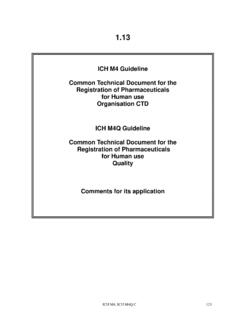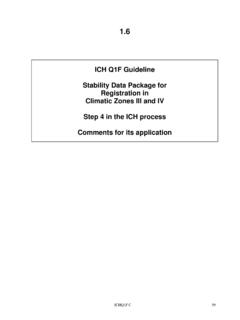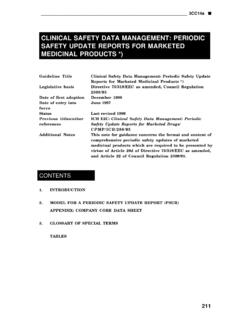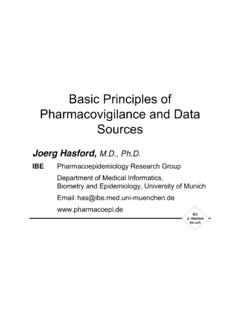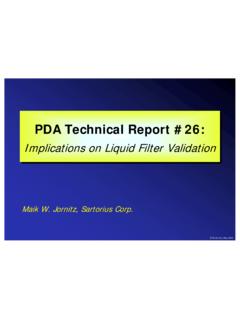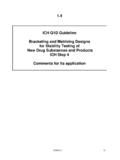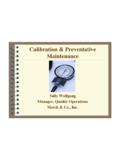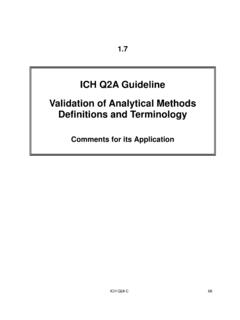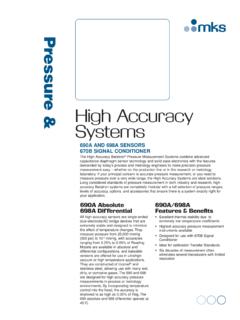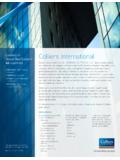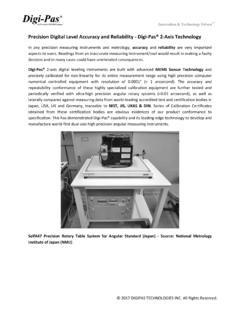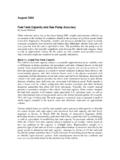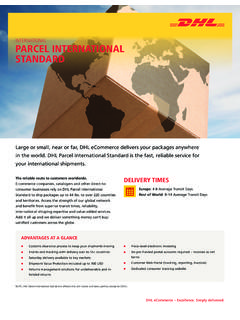Transcription of VALIDATION OF ANALYTICAL METHODS - IKEV
1 VALIDATION . OF. ANALYTICAL METHODS . international . international QUALITY. QUALITY SYSTEMS. SYSTEMS. 1. GERT BEUVING. international PHARMACEUTICAL OPERATIONS. international QUALITY SYSTEMS. TASKS: - Internal auditing - Auditing of suppliers and contract manufacturers - Preparing for and guiding of external inspections - Review of and advice on procedures & validations international . international QUALITY. QUALITY SYSTEMS. SYSTEMS. 2. General VALIDATION FDA-guidelines: VALIDATION is establishing documented evidence which provides a high degree of assurance that a specific process will consistently produce a product meeting its pre-determined specifications and quality attributes EU-guidelines Action of proving, in accordance with GMP-principles that any procedure, process, equipment, material, activity or system actually leads to the expected results international .
2 international QUALITY. QUALITY SYSTEMS. SYSTEMS. 3. General Conclusion: - Need for pre-determined operational & performance user requirements (URS) of process or system - Provide evidence of meeting pre-defined operational &. perfomance requirements - Provide evidence on consistency of meeting these requirements international . international QUALITY. QUALITY SYSTEMS. SYSTEMS. 4. General More specific: METHODS VALIDATION is the process of demonstrating that ANALYTICAL procedures are suitable for their intended use . (ICH Topic Q2B, March 1995). international . international QUALITY. QUALITY SYSTEMS. SYSTEMS. 5. General Why VALIDATION ? 1. GMP-legislation 2. Good economics 3. Good science practices international . international QUALITY. QUALITY SYSTEMS. SYSTEMS. 6. VALIDATION guidelines Guidelines 1. ICH Q2A.
3 Text on VALIDATION of ANALYTICAL procedures: Definitions and terminology (March 1995). 2. ICH Q2B. VALIDATION of ANALYTICAL procedures: Methodology (June 1997). 3. FDA. (Draft) Guidance for Industry: ANALYTICAL procedures and METHODS VALIDATION 4. Pharmacopoeias USP and European Pharmacopoeia international . international QUALITY. QUALITY SYSTEMS. SYSTEMS. 7. Guidelines What METHODS to be validated? Defined for: - identification - quantitative tests for content of impurities - limit tests for control of impurities - quantitative tests for active moiety in drug substances and drug products Referred to: - dissolution testing - particle size determination (drug substance). international . international QUALITY. QUALITY SYSTEMS. SYSTEMS. 8. Guidelines When should METHODS be validated? Development and tox: No VALIDATION required Phase 1.
4 No VALIDATION data required Phase 2. For both drug substance and drug product supporting VALIDATION data on ANALYTICAL METHODS should be available on request international . international QUALITY. QUALITY SYSTEMS. SYSTEMS. 9. Guidelines When should METHODS be validated? Phase 3 (Pivotal studies): Appropriate VALIDATION information should be provided. Assay VALIDATION should cover accuracy , precision, specificity (including stress testing), quantitation & detection limits, linearity and range (where appropriate). Degradation should be identified, qualified and quantified NDA submission Full VALIDATION reports of relevant METHODS must be included international . international QUALITY. QUALITY SYSTEMS. SYSTEMS. 10. Guidelines What aspects to cover? Specificity: Definition: Ability to assess unequivocally the analyte in the presence of of components which may be expected to be present (impurities, degradants, matrix).
5 Aspects: - Identification - Purity tests - Assay (Content/potency). international . international QUALITY. QUALITY SYSTEMS. SYSTEMS. 11. Guidelines Linearity: Definition: Ability (within a specified range) to obtain test results which are directly proportional to the concentration of analyte in the sample Aspects: - Test across the range (at least 5 concentrations). - Evaluate linearity by visual inspection of the plot and by statistical techniques - Calculate corr. coefficient, y-intercept, slope and res. sum of squares international . international QUALITY. QUALITY SYSTEMS. SYSTEMS. 12. Guidelines Range: Definition: Interval between upper and lower concentration of the analyte in the sample for which it has been demonstrated that the procedure has a suitable level of precision, accuracy and linearity Aspects: - Defined from linearity study - Depends on the application of the method (assay, dissolution test, content uniformity).
6 international . international QUALITY. QUALITY SYSTEMS. SYSTEMS. 13. Guidelines accuracy Definition: Expresses the closeness of agreement between the value which is accepted either as a conventional true value or an accepted reference value and the value found. METHODS : Drug substance - use of reference standard with known purity - comparison with independent, well-characterised procedure - may be inferred once precision, linearity and specificity are established international . international QUALITY. QUALITY SYSTEMS. SYSTEMS. 14. Guidelines accuracy Drug product - spiking of placebo mixture - addition of analyte to active' material - comparison of results obtained with independent, well-characterised procedure - may be inferred once precision, linearity and specificity are established Impurities - spiking of product samples - use of independent, well-characterised procedure international .
7 international QUALITY. QUALITY SYSTEMS. SYSTEMS. 15. Guidelines accuracy Recommended data - Assessed by 9 determinations over a minimum of 3 concentration levels covering the specified range - To be reported as percent recovery international . international QUALITY. QUALITY SYSTEMS. SYSTEMS. 16. Guidelines Precision Definition Closeness of agreement ( scatter') between a series of measurements obtained from multiple sampling of the same homogeneous sample. Aspects - Repeatability - Intermediate precision - Reproducibilty international . international QUALITY. QUALITY SYSTEMS. SYSTEMS. 17. Guidelines Precision - Repeatability Definition Precision under the same operating conditions over a short interval of time. Method - 9 determinations covering the specified range - or: 6 determinations at 100% of the test concentration international .
8 international QUALITY. QUALITY SYSTEMS. SYSTEMS. 18. Guidelines Precision - Intermediate precision Definition Expresses within laboratory variations. Method - Depends on circumstances of usage of the METHODS - Should include variations in days, analists, columns international . international QUALITY. QUALITY SYSTEMS. SYSTEMS. 19. Guidelines Precision - Reproducibility Definition Precision between laboratories Method - Dependent on usage of method - Should include interlaboratory study international . international QUALITY. QUALITY SYSTEMS. SYSTEMS. 20. Guidelines Detection limit Definition Lowest amount of an analyte in a sample which can be detected but not necessarily quantitated. Method - Based on visual evaluation - Based on signal-to-noise ratio (3:1). - Based on (SD) of response and slope (DL= ).
9 - Report results and method of choice international . international QUALITY. QUALITY SYSTEMS. SYSTEMS. 21. Guidelines Quantitation limit Definition Lowest amount of an analyte in a sample which can be quantitatively determined with a suitable precision and accuracy Method - Based on visual evaluation - Based on signal-to-noise ratio (10:1). - Based on (SD) of response and slope (DL=10xSD/S). - Report results and method of choice international . international QUALITY. QUALITY SYSTEMS. SYSTEMS. 22. Guidelines Robustness Definition Measure of the capacity of a method to remain unaffected by small variations in method parameters. Aspects - To be considered during development - To be used for establishment of system suitability criteria - Include testing of stability of solutions - To be tested by introducing small variations in method parameters international .
10 international QUALITY. QUALITY SYSTEMS. SYSTEMS. 23. Guidelines System Suitability Test Definition Set of parameters and criteria thereoff to ensure the system is working properly. Aspects - Dependent on type of test - For chromatographic METHODS : tailing factor, rel. retention times, resolution factor, rel. st. deviation, number of theoretical plates - To be checked before start of run and to be verified afterwards - Described in Pharmacopoeias international . international QUALITY. QUALITY SYSTEMS. SYSTEMS. 24. Recommended VALIDATION characteristics of various Types of Tests Type of tests/ Assay/ Specific Identification Testing for impurities Characteristics Dissolution Tests Quantitative Limits accuracy - + - + +. Precision-repeatability - + - + +. Precision- - + - + +. Intermediate precision Specificity + - + + +.
